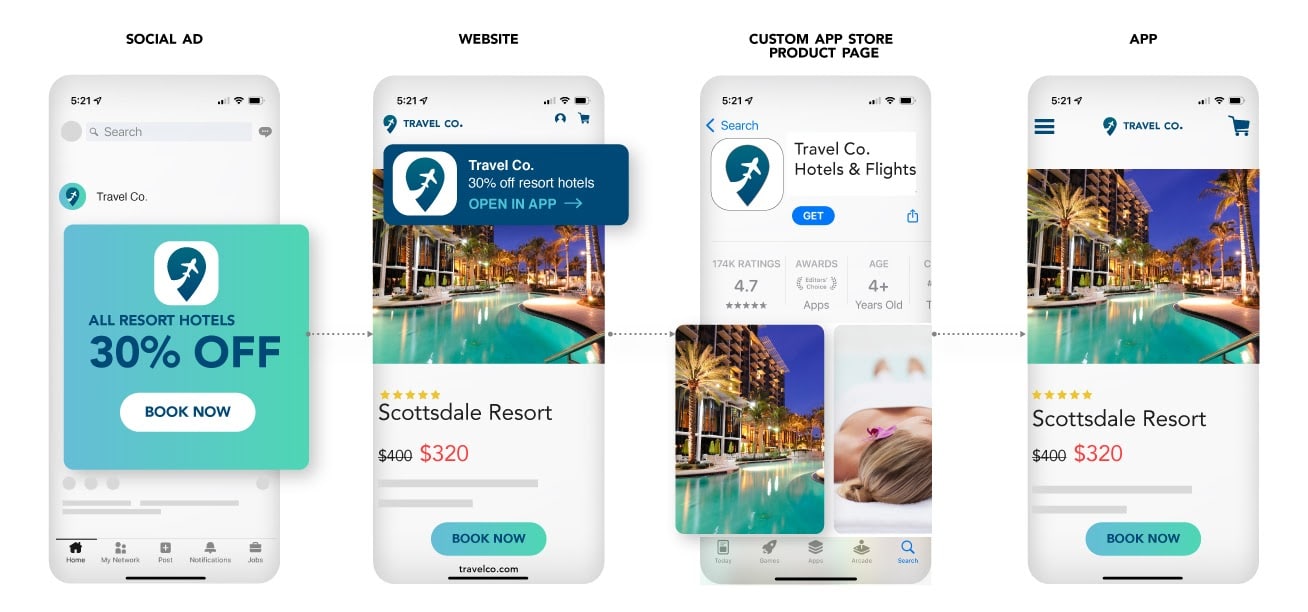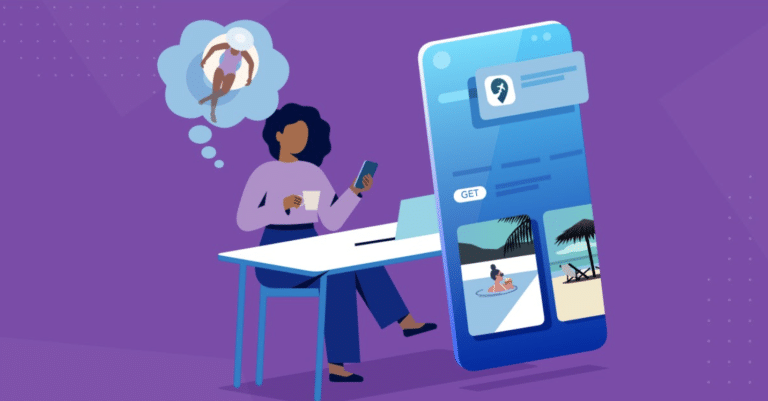At Apple’s annual Worldwide Developer Conference (WWDC) in June, the company announced two new iOS 15 App Store features that they planned to release toward the end of 2021. Well, that moment is finally here. Both new features are now live and available.
The first feature highlighted at WWDC was Product Page Optimization (a.k.a. A/B testing). For the purposes of this blog, we will focus our attention on the other feature they announced – Custom Product Pages for the App Store. This Apple feature allows brands to target different variations of app content toward specific users by creating unique App Store pages, and Branch is excited to provide out-of-the-box support on day one.
What are Custom Product Pages?
Apple’s new Custom Product Pages (in iOS 15 or iPadOS 15) allow marketers to create more relevant, differentiated pages on the App Store that can be tailored to specific target audiences and linked to individual campaigns with a unique URL. Brands can personalize their App Store pages (up to 35 variations) with alternate versions of app preview videos, screenshots, and copy, each designed to focus on a unique audience. Each page is also fully localizable.
Apple created this feature so brands can leverage these pages to offer seamless, contextual install experiences to targeted users across the entire marketing journey. With the ability to create hyper-targeted pages, Apple is hoping brands will be able to increase conversion rates by delivering experiences that fit more closely with users’ content expectations when they arrive on an App Store page.
Brands can use this unique app page link throughout their marketing efforts, including in paid advertising, social posts, email campaigns, and promotional communications. For example, a travel app could create an app page that highlights content around ‘Resorts’ and promote offers with that link, across their channels, to audiences interested in spas, massages, etc.

Setup is Easy. Content is the key
The process of setting up a Custom Product Page is easy, provided you have the content ready to go for each page. When you’re ready, simply navigate to the My Apps tool and choose whether to start with a blank page or make changes to an existing product page. You can choose an existing version in a ‘Ready for Sale’ or ‘Prepare for Submission’ state.
For each variation, you can modify screenshots, app previews, or promotional text to match your chosen target audience. Depending on the audience, just update each section of the page with relevant content. Although you can change many content elements, you are not able to create a custom icon (at this time). After you finalize the page content, it is ready to submit for review!
Once the page is ready, a unique URL is automatically generated. However, there are a few details about the links that you should know:
- A unique link can’t be changed or reused for a different page, and it remains consistent for all future versions of the page.
- You can disable a link if you need to pause a marketing campaign or it is not performing. If someone clicks the disabled URL, they’ll be automatically redirected to your default app page.
- The links can be used across your marketing channels, but they don’t appear when someone searches for your app on the App Store.
- Similar to other App Store links, deep linking still does not work out of the box in iOS 15. More on that later.
Plenty of marketing benefits
The main selling point of Apple’s Custom Product Pages is the ability to offer variants of App Store pages to different audiences. By tailoring each product page variation to match your marketing campaigns, you will create better, more consistent experiences that should result in stronger engagement and higher conversion.
Apple has included the ability to pause Custom Product Pages based on the success of the page, seasonality, or changes in marketing strategy. As you measure metrics such as engagement, retention, and average revenue per user (ARPU), you will be able to optimize performance over time and keep the winning pages running while making improvements to (or pausing) sub-optimal pages.
With the release of Custom Product Pages, Apple has filled a hole in the customer marketing journey. Now, no matter whether that journey starts with an email, paid ad, or a visit to your website, you can provide a contextual experience for a hyper-targeted audience across your channels and drive them to relevant content in your app — ideally, driving higher conversions and ultimately, higher LTV.
Branch has built-in support
As we highlighted earlier, the App Store still does not support deep links out of the box, and that has not changed with the introduction of Custom Product Pages. However, you can easily add deep linking (and deferred deep linking) support for your pages using Branch links. For each Branch link you want to use with a Custom Product Page, simply set the $ios_url value to the custom page’s unique URL (the same parameter also works for the CTA button in Journeys smart banners).
As always, Apple’s built-in App Store Connect reporting will provide basic metrics like impressions, downloads, and conversion rates for each product page version. To see more advanced performance reporting for Custom Product Pages in the Branch dashboard, we make it easy: just set a unique value for each page variation via a Branch analytics label (such as ~tags).
No matter how sophisticated your marketing strategy is, this Apple feature opens a whole new world of contextual marketing journeys that were never available before.
Custom Product Pages from Apple are available now and Branch is ready to support you.






















